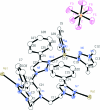Poly[[{μ(3)-tris-[2-(4-phenyl-1,2,3-triazol-1-yl)eth-yl]amine}silver(I)] hexa-fluorido-phosphate]
- PMID: 21201012
- PMCID: PMC2959415
- DOI: 10.1107/S1600536808028298
Poly[[{μ(3)-tris-[2-(4-phenyl-1,2,3-triazol-1-yl)eth-yl]amine}silver(I)] hexa-fluorido-phosphate]
Abstract
The title compound, {[Ag(L)]PF(6))(n) {L is tris-[2-(4-phenyl-1,2,3-triazol-1-yl)eth-yl]amine, C(30)H(30)N(10)}, consists of alternating two-dimensional cationic layers of [Ag(L)](+) and anionic PF(6) (-) layers. Each Ag(I) atom is three coordinated in a T-shaped geometry by three N atoms from three ligands. Each ligand links three Ag(I) atoms, generating a two-dimensional network structure with two different metallacycles, A and B. In A, eight coordination units from four ligands connect four Ag(I) atoms, forming a 48-membered ring. In B, four coordination units from two ligands link two Ag(I) atoms, forming a 24-membered ring. Each B ring is surrounded by four A rings, and each A ring has four A and four B rings as neighbours. This cationic layer thus generates a 4.8(2) topology network, with each Ag(I) centre and ligand acting as a three-connected topological node.
Figures


References
-
- Altomare, A., Burla, M. C., Camalli, M., Cascarano, G. L., Giacovazzo, C., Guagliardi, A., Moliterni, A. G. G., Polidori, G. & Spagna, R. (1999). J. Appl. Cryst 32, 115–119.
-
- Betteridge, P. W., Carruthers, J. R., Cooper, R. I., Prout, K. & Watkin, D. J. (2003). J. Appl. Cryst.36, 1487.
-
- Burnett, M. N. & Johnson, C. K. (1996). ORTEPIII Report ORNL-6895. Oak Ridge National Laboratory, Tennessee, USA.
-
- Jacobson, R. (1998). Private communication to the Rigaku Corporation, Tokyo, Japan.
-
- Newkome, G. R., He, E. & Moorefield, C. N. (1999). Chem. Rev.183, 1689–1746. - PubMed
LinkOut - more resources
Full Text Sources
Research Materials
